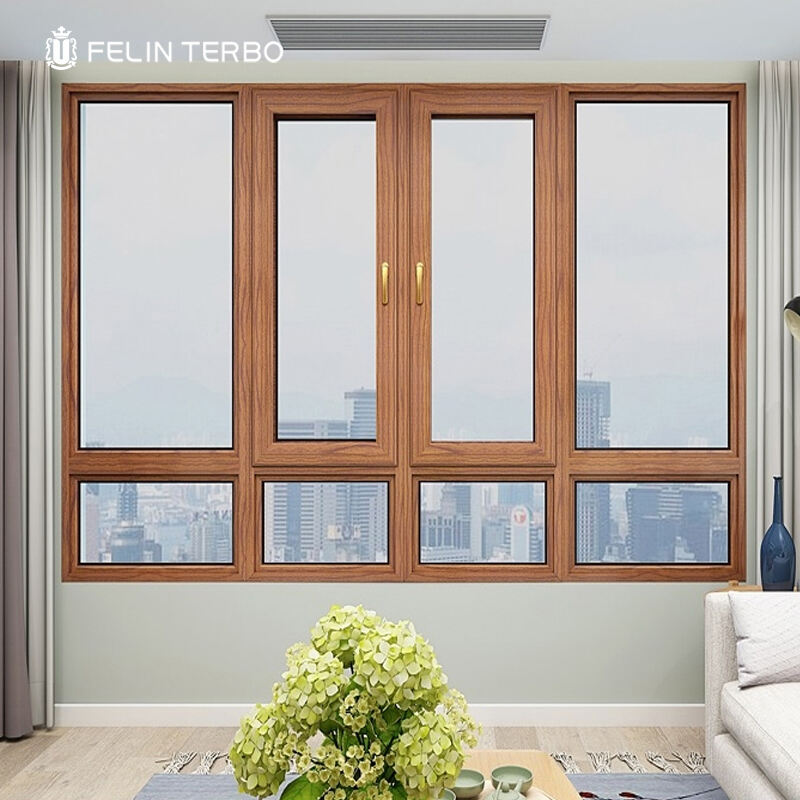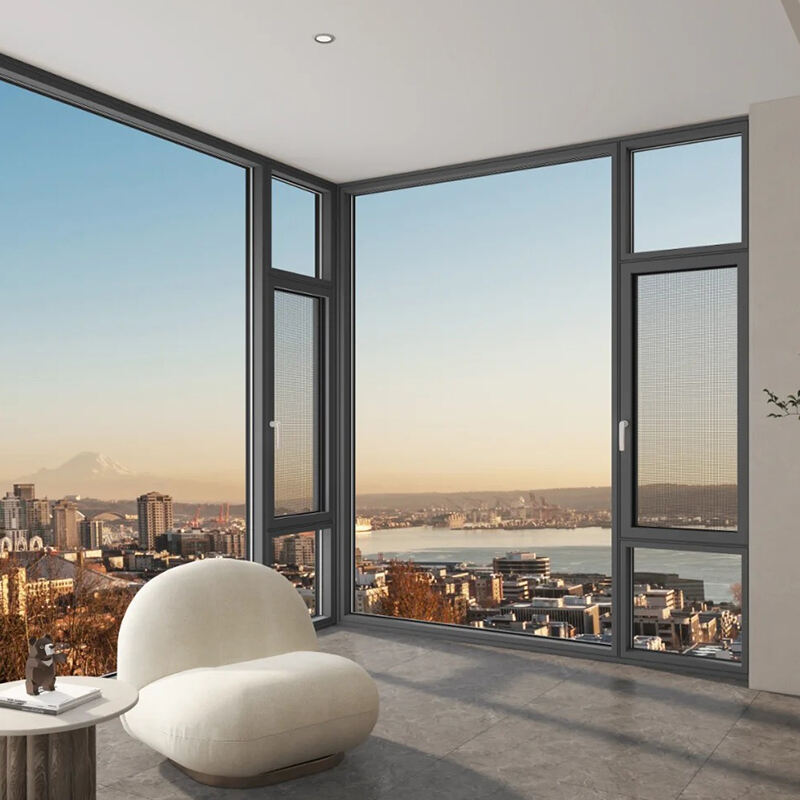הגדרת סגנון חלון דלת לפי המכניקה שלו
עקרונות תפעול של חלונות דלת
חלונות שמש מתופעלים באמצעות צירים אנכיים ומנקהל ידני, ונפתחים החוצה כדי לאפשר רוח צולית. כאשר הם סגורים, העיצוב שלהם יוצר חותם אוויירטי, ומביא לשיפור של עד 50% בוויסות התרבויות לעומת דגמים منزلקים (Energy Star 2023). המנכהל הזה קל מאוד לשימוש ומייצר שינויי לחץ מצוימים כדי למקסם את זרימת האוויר.
ההתפתחות ההיסטורית לצורות עיצוב מודרניות
הם החלו כמסגרות עץ או ברזל עם צירים, והיו כוללים מבנה חדיר של נייר מחורץ או בד שופן שנבלעו במשחה במשך מאות שנים, אך עם הזמן התפתחו לצורתם הנוכחית של זכוכית שמסומנת ברשת של עופרת במגוון יחסי צדדים. הדגמים המתקדמים יותר של חלונות אלו מציגים קווים דקים יותר, מנשא חלקים ומערכות ציר יציבות יותר. התקדמות מהשנים שלאחר 1970 הכניסה צלעות מחוזקות ומנועים דו-זקניים, מה שהוביל לביצועים מבניות מתקדמות נגד עומסים של רוח שמעל 50 פאונד לאינץ' רבוע (איגוד החלונות 2022).
הסברים על מנגנוני תצפית לא מופסלת
פסי זכוכית קבועים מותקנים בקצוות בחלונות דלת, ומבלי פסי חלוקה מרכזיים שמפרקים את הנוף. תצורות של חלון יחיד שומרות על 94% משטח הזכוכית הגלוי, לפי מדדי חסימת תצפית (חלון ודלת 2022). האסתטיקה ה ללא מסגרת מאפשרת לאדריכלים למקסם את קווי התצפית על ידי מיקום של מסגרות מחוץ לזווית הראייה.
ההשפעה של החומרים על מגמות פונקציונליות
מבנה השרף קובע את היעילות האופרציונלית של החלון; ויניל הוא החומר המבודד ביותר (יכול לספק אורך חיים גדול ב-30% מכיוון שהחלון פחות סביר להתפתל, בעוד אלומיניום מעדיף חוזק על בידוד. היברידים חדשים של סיבי זכוכית עם חומרים סינתטיים זמינים כעת בערכים של U <0.30 עם תמיכה מבנית. עץ דורש חותם תקופתי אך ניתן לעיבוד מותאם אישית בדרך שאינה אפשרית בחומרים סינתטיים. מקדמי ההתפשטות התרמית משתנים מאוד בין החומרים השונים - ויניל מתרחב ב-3.8 מיקרון/מטר מעלות צלזיוס, בעוד שאלומיניום מתרחב ב-22 מיקרון/מטר מעלות צלזיוס (ASTM International 2023).
שיקולים בחומרים עבור סגנון חלון דלתית

ויניל לעומת עץ: מבחן תחזוקה ויעילות
מסגרות ויניל מונעות שימוש בצבע ומאפשרות 72% פחות תחזוקה מאשר עץ (מכון חומרי החלונות 2023). הבנייה מרובת תאים שלהם יכולה לספק מקדמי תקשורת תרמית (U-Factor) נמוכים כמו 0.28, מה שמעל על ביצועים תרמיים של מסגרות עץ רגילות (בממוצע 0.35). חלונות עץ מציעים ירידה טובה יותר של רעש (גבוהים ב-4-6 במדד STC) אך החותם חייב להישקף כל 2–3 שנים כדי למנוע עיוותים עקב לחות. לדוגמה, בעוד שחלונות ויניל נמשכים בדרך כלל 25 עד 30 שנה, חלונות מעץ איכותי מורשת יכולים להימשך יותר מ-75 שנה עם תחזוקה – ניקוד שאפשר להצדיק את 38% הגבוה יותר במחיר – זה יקר להחליף שליש מהחלונות בבית לאורך זמן.
אלומיניום וסיבי זכוכית: ניקוד עמידות
סיבי זכוכית עמידים בתהליך קורוזיה של מי מלח פי 3 יותר מאלומיניום בבדיקות גילויון מואץ (ASTM B117 2023). מסגרות אלומיניום דורשות שבת תרמית כדי למזער מוליכות תרמית של 210 וואט/מטר × קלווין, 18-22% מהות של הייצור. סיבי זכוכית הוא חומר רך יותר, וברמה רבה גמיש יותר, שנותר יציב ביחס לשינויים בממדים דרך טווח טמפרטורות של 140 מעלות פארנהייט ושיעור התפשטות ליניארי אפס [!!] – זה מאוד חשוב ביחידות חלון גדושות. שני החומרים תומכים בשילוב זכוכית משולשת, אך סיבי זכוכית בעלי חוזק מתיחה גבוה יותר (1,000 מגה פסקל לעומת 450 מגה פסקל באלומיניום) מהווים קו מבט צר ב-40% עבור שטח זכוכית מרבי.
ניתוח עלות סביבתית בין החומרים
תיבות עץ עם תעודת FSC סופגות 28 ק"ג פחמן דו-חמצני לכל חלון בשנה – במהלך 7 שנים הן יפחתו את פליטת הפחמן מהתעשייה (Sustainable Forestry Initiative 2023). אלומיניום מחזורית (שכוללת 70% תוכן תעשייתי לאחר עיבוד) דורשת 65% פחות אנרגיה לייצור בהשוואה לחומר טהור, אך עדיין יוצרת 11.5 ק"ג פחמן דו-חמצני לקילוגרם. בשלבי הייצור, ויניל יוצר 3.2 ק"ג פליטת חומצה כלוריתת לכל יחידה, בהשוואה לזכוכית פיברגלס עם 55% תוכן זכוכית מחזורית, אשר מקטינה את האנרגיה המשותקת ל-18 מג'א'/ק"ג – 46% פחות בהשוואה למוצרים אלטרנטיביים של פוליויניל כלוריד. הערכה מחזורית של 50 שנה מראה את העלות הסביבתית הנמוכה ביותר עבור פיברגלס ($185/יחידה) וכן את הערך השני הנמוך wood ($210) אם שניהם תופנו כראוי.
סינרגיה ארכיטקטונית עם סגנון חלונות דוחקים
מסדרת אומן ועד עכשווי: מסגרת התאמה של סגנונות
חלונות דלת מתקפלים יעברו בקלות דרך תקופות ארכיטקטוניות, ו-78 אחוז מהמעצבים בסקר של האגודה הלאומית של בוני בתים לשנת 2023 заяמרו כי חלונות דלת הם הסגנון הרגילים ביותר כשמעורבבים. לבungalואים בסגנון קרפטסמן, חלונות עץ עם תאורה מחולקת מדגישים מגע אומנותי; ב בתים עכשוויים, מסגרות אלומיניום דקיקות וזכוכית נדיבה יוצרות תוצאה חסכונית וминימליסטית יותר. צורות קשיחות היסטורית כאלה זמינות כעת גם בדגמים מותאמים אישית של סריגים (פרairie, קולוניאלי) ובסוגי גימורי מתכת (ניקל מוברש, נחושת מומחת) כדי להרחיב את היקף הארכיטקטורה מבלי להתפשר על האפיון.
הפארדוקס של רווח תפעולי במרחבים צרים
למרות שחלונות ההזזה מתאימים לשאיבת אויר, ההזזה החוצה תופסת מקום במרחבים קטנים, כמו מטבחים צרים או מסדרונות דקים. סקר של איגוד יצרני חלונות ושערים מ-2022 קבע ש-34% השתמשו בעומק שדרה נמוך (4") או צירים ביצועיים כדי לאפשר הפעלה של 90° במרווח של 18". מיקום אסטרטגי מעל משטחי עבודה או בקרבת שבילים פותר את הסתירה הזו, ומאפשר שאיבת אויר מלאה במקום פגיעה בזרימה הארגונומית בדירות קטנות (למשל <50 מ"ר).
מקרים לשיפור המראה החיצוני
לפי ניתוח של RE/MAX משנת 2021, בתים עם קבוצות (3+) של חלונות דחפור כמאפיין עיצוב נמכרו ב-14% מהר יותר מאלו עם סגנונות התקנה בודדים. לבתים על החוף הוענקה הערכת שווי גבוהה יותר ב-23% עבור חלונות דחפור מוויניל מצופים עם SDLs (חלונות מחולקים מדומים) כדי להתגבר על התפזרות המלח, ולשמור על "המראה של ניו אינגלנד". בסקר קוראים שנערך בשנת 2023 על ידי Architectural Digest, חלונות דחפור עם זכוכית עטופה ברעף וידיות ברזל מוברגות בסגנון טודור גרמו לעלייה של 41 אחוז בהשראת אותנטיות.
בחירת סגנון חלון קסמט על פי ביצועים
מדדי יעילות אנרגטית: תעודת הרישוי של ה-NFRC מוסברת
המועצה הלאומית להערכה של פתחים (NFRC) מספקת מדדים סטנדרטיים להערכת הביצועים האנרגטיים של חלונות קסמט. מדדים עיקריים כוללים:
- מקדם U: מודד העברת חום (נמוך יותר = בידוד טוב יותר), עם מודלים בעלי ביצועים גבוהים ביותר המגיעים ל-0.25 ₪ (NFRC 2023)
- מקדם חדירת חום שמשי (SHGC): קריטי לאקלימים חמים, שם ערכים נמוכים מ-0.27 מונעים חדירה מוגזמת של אנרגיית שמש
- דליפת אוויר: עיצובים מתקדמים מגבילים את זרימת האוויר ל-0.05 CFM/ריבוע רגל תחת לחץ של 75Pa
נתונים אלו עוזרים לבעלי בתים לחשב חיסכון באנרגיה של 12-18% שנתיamente לעומת חלונות בודדים.
יעילות הניהול באקלימים מגוונים
חלונות דלתן משיגים 96% נפח זרימה של אוויר כאשר הם פתוחים לחלוטין, ומעלים ב-41% את הביצועים של חלונות הזזה (מכון היעילות בחלונות 2023). המעצב הידראולי יוצר דפוסי זרימה מכוונים המאידיאליים ל-:
- אזורים לחים: אוורור צולב מפחית את הסיכונים לצמיחת עובש
- אזורים יבשים: פתחים הניתנים להתאמה מפחיתים את חדירת האבק
- אזורים חופיים: מיקום בזווית מוסיפה לסתור את טיפות המלח
מחקרים עדכניים מראים שהגאומטריה הטרפזית של הפתחים מגדילה את קצב החלפת האוויר ב-33% במהירות רוח נמוכה מ-15 מייל לשעה.
ניתוח נתוני בדיקת התנגדות לסערה
בדיקות סימולציה במעבדה מראות כי חלונות דלתית יכולים לעמוד ב:
- עומסי רוח: עד 4,800 פסקל (שקול לרוחות של 140 מייל לשעה)
- אפקטים של גופים נעים: עברו את בדיקת ASTM E1886 עם קרשים של 2x4 פאונד במשקל של 9 ליברות במהירות 34 מייל לשעה
- דליפת מים: שמרו על החותם בלחץ של 8.5 פאונד לאורך הריבועי (תנאי הוריקן)
עיצובים עם גלוי אלומיניום מציגים שיפור של 28% בעמידות התפלגות העומס לעומת שלדות פלסטיק בלבד בבדיקות מחזוריות (דוח הבנייה החופית 2023).
הימנעות מטעויות התקנה בסגנון חלון דלתית
מקרי בדיקה של שגיאות מדידה ואסטרטגיות למניעתן
סקר של אלייאנס התעשייה לחלונות מ-2023 גילה כי 38% מקריאות השירות בחלונות דלתית קשורות לשגיאות מדידה, אשר גובות בממוצע 420 דולר מהבעלים לצורך תיקונים. מקרי כשלון תועדו, כולל פרויקט שיקום בבוסטון שבו סטיות של 12 מ"מ בפר frame גרמו לדליפת אוויר מתמדת (הגדלה של 0.45 ACH), והביאו להחלפת כל היחידה. הפתרון דורש:
- כלים מדידת לייזר שמקטינים שגיאות אנושיות ב-72% (NIST 2022)
- גודל מותאם לעונה (אפשר הרחבה של 1.5 מ"מ למטר ליניארי עבור ויניל)
- פרוטוקולים לאימות צד שלישי לפני חיתוך זכוכית
וויכוחים על תואם חומרה
מחקרי התקנת חלונות עדכניים מראים כי החזקת מברג הפתילה חזק מדי נותרה השגיאה הנפוצה ביותר של המתקין, ופוגמת בשלמות המסגרת ב-1 מתוך 3 פרויקטים (WDMA 2023). הענף מתמודד עם וויכוחים מתמשכים בקשר ל-
- מפרקי תקן לעומת מפרקים לפי מפרט היצרן (ISO 898-1 לעומת מערכות סגורות)
- דרישות לחיזוק קומפוזיט עבור זכוכית כבדה (18 ק"ג/מ"ר)
- קושי בהטמעת מנעול חכם עם מסגרות לפני 2005
פתרונות מניעתיים כוללים מפתח טורק דيجיטלי (דיוק ±2%) וביקורת תאימות חומרה לפני ההתקנה באמצעות פרוטוקולי סימולציה ASTM E2838.
מגמות עתידיות בטכנולוגיית חלונות דלתית
תחזית להטמעת טכנולוגיית זכוכית חכמה
לפי מחקרים שוקיים עדכניים, צפוי עלייה בשימוש בزجاج חכם בחלונות בתים פרטיים ותגיע ל-63% עד שנת 2026, וזאת כתוצאה מהשלמה מוגדלת של טכנולוגיית האינטארנט של הדברים (IoT), המאפשרת התאמה אוטומטית של החשכה, בשליטה דרך טלפונים חכמים. טכנולוגיה אלקטרוכרומטית מפחיתה את קליטת החום השמשי ב-34% במקסימום, תוך שמירה על 92% העברת אור נראה (NFRC 2023). עם מערכות חדשות של ימינו, שילוב ה-PV Edge עם פאנלים סולריים מייצר 12–18 וואט למטר מרובע בשעות היום—מספיק כדי להפוך את ההתקנות למאוחדות ולתמוך במאמצי בנייה של בתים עם אפס פלט נקי.
חידושים בחומרים ברמה של מחקר
המעבר לחומרים מעגליים הביא לתהודה של חומרים המבוססים על פטריות מייצרות, שמנעים בידוד superior מвинיל בכ-200% ויתנוון ביולוגית לחלוטין תוך 18 חודשים לאחר זריקתם. הערכה מחזורית משנת 2024 חשפה שצורות ביוקומפוזיט יכולות להציל עד 58% בפליטות ייצור בהשוואה לצורות אלומיניום שקולות. טיפול בחומרי הרחקה נייטרליים פחמן מונע לחלוטין את פליטת הפורמלדהיד לתוך הבית, וכן מכפיל ומש triple את משך חיי הריהוט ל-25 שנים ומעלה (לחשוב על מה זה אומר לאקלים חוף או לחוף).
שאלות נפוצות על חלונות דלת
מהן היתרונות העיקריים של חלונות דלת?
חלונות דלת מציעים הנעה superior, סגילה אוויר אטומה, ומבט בלתי מוסך. הם גם קלים להפעלה ומספקים בידוד מצוין, מה שהופך אותם לבחירת אנרגיה יעילה עבור רבים מבני בתים.
איך חלונות הדלת משווים במונחי תחזוקה?
חלונות עפפות מвинיל דורשים תחזוקה מינימלית לעומת עץ, אשר דורש חותם תקופתי למניעת עיקום.מצד שני, עץ יכול לספק חימול ארוך יותר עם טיפול נאות.
האם חלונות עפפות מתאימים לכל סגנונות האדריכליים?
כן, חלונות עפפות הם גמישים וייתכן להתאים אותם גם לסגנונות אדריכליים מסורתיים וגם מודרניים, תוך מתן אפשרויות התאמה שונות כדי להתאים את האסתטיקה של העיצוב.
אילו חומרים הם הטובים ביותר לחלונות עפפות?
בחירת החומר תלויה בעדיפויות כמו בידוד, חוזק ותקציב. ויניל מציע בידוד טוב, אלומיניום מספק חוזק, בעוד סיבי זכוכית ועץ מציעים יתרונות בגמישות ובאסתטיקה בהתאמה.

 EN
EN








































